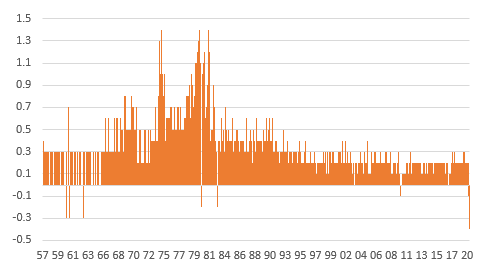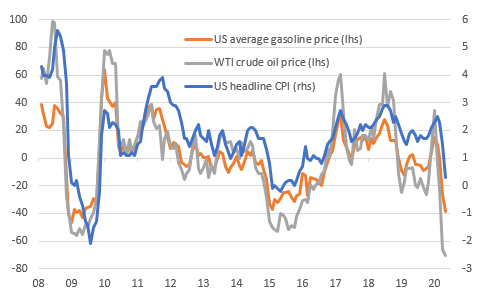US: Deflationary forces intensify
The first back-to-back monthly falls in core inflation in 38 years underlines the deflationary impact of the Covid-19 crisis
| -0.4% |
The weakest ever core CPI readingMonth-on-Month |
April 2020 sets new records
The US consumer price inflation report showed prices fell 0.8% month on month in April, dragging the annual rate of inflation down to just 0.3% as gasoline prices plunged more than 10%. However, the bigger news is that core inflation (excluding food and energy) has recorded consecutive MoM declines for only the second time in the series’ 63-year history – the last time was 1982. This reinforces our view that the scale of demand destruction in the economy means inflation is not going to be an issue for a long time.
After falling 0.1% MoM in March, core CPI was down 0.4% MoM in April as apparel (-4.7% MoM), public transport (-8.5%), airline fares (-12.6%) and lodging away from home (-6.8%) experienced collapsing prices. Moreover, this is the biggest MoM decline for core CPI ever – there were three -0.3% MoM readings in the early 1960s, a couple of -0.2% MoM in the early 1980s and just one -0.1% in January 2010, which highlights how significant an impact Covid-19 has had on pricing power in the US economy.
MoM% changes in core (ex food & energy) prices 1957-2020

Food to remain an outlier
As for the headline index, the steep decline in energy prices was the obvious driver. However food (+1.5% MoM) is likely to remain one of the few sources of inflation pressures as food supply chains and networks have to be adapted to the new environment where grocery demand outstrips restaurant food consumption. Historically, similar amounts of money have been spent at both.
Nonetheless, we expect annual inflation to move into negative territory in coming months as a combination of very weak core inflation pressures and steep energy price falls continue to feed through. The national average gasoline price tumbled from US$2.44/gallon at the start of March to US$1.76 by the end of April. Today, gasoline in Van Buren county, Arkansas is the cheapest nationally, costing just US$1.35/gallon, according to the AAA.
US headline inflation and energy and gasoline prices (YoY%)

Inflation has further to fall
The collapse in demand sparked by virus containment measures has been astonishing and meant that businesses desperate for cash have been slashing prices across the board. Inventory levels are high and with the US economy having lost something of the order of 35-40 million jobs, the negative implications for demand mean more clearance discounts are likely going to be required. Indeed, today’s National Federation of Independent Business survey showed a net -18% of small business are experiencing rising selling prices versus +6% in March. This suggests core CPI is heading to below 1% year on year, just as it did during the Global Financial Crisis.
Of course, we hear the argument that the Federal Reserve "unlimited" quantitative easing is bound to eventually generate inflation, but we heard that after the Fed’s QE1, QE2 and QE3 programmes. The key question is will the money find its way into the pockets of consumers, or is it going to stay in financial assets? Last time round QE certainly contributed to asset price inflation, yet CPI remained stubbornly low and, at least at this stage, we see little reason for it to be different this time.
This publication has been prepared by ING solely for information purposes irrespective of a particular user's means, financial situation or investment objectives. The information does not constitute investment recommendation, and nor is it investment, legal or tax advice or an offer or solicitation to purchase or sell any financial instrument. Read more
Download
Download snap